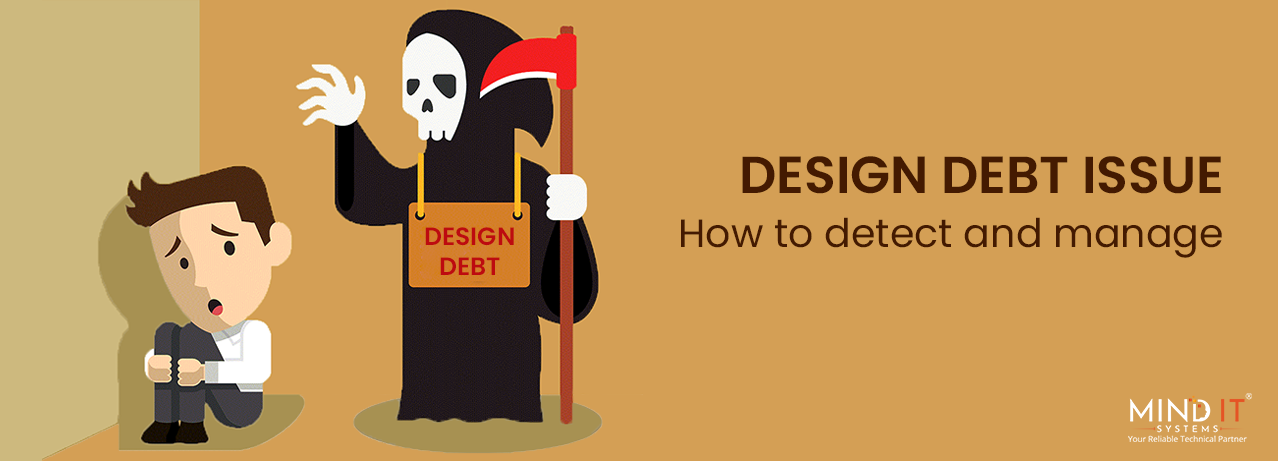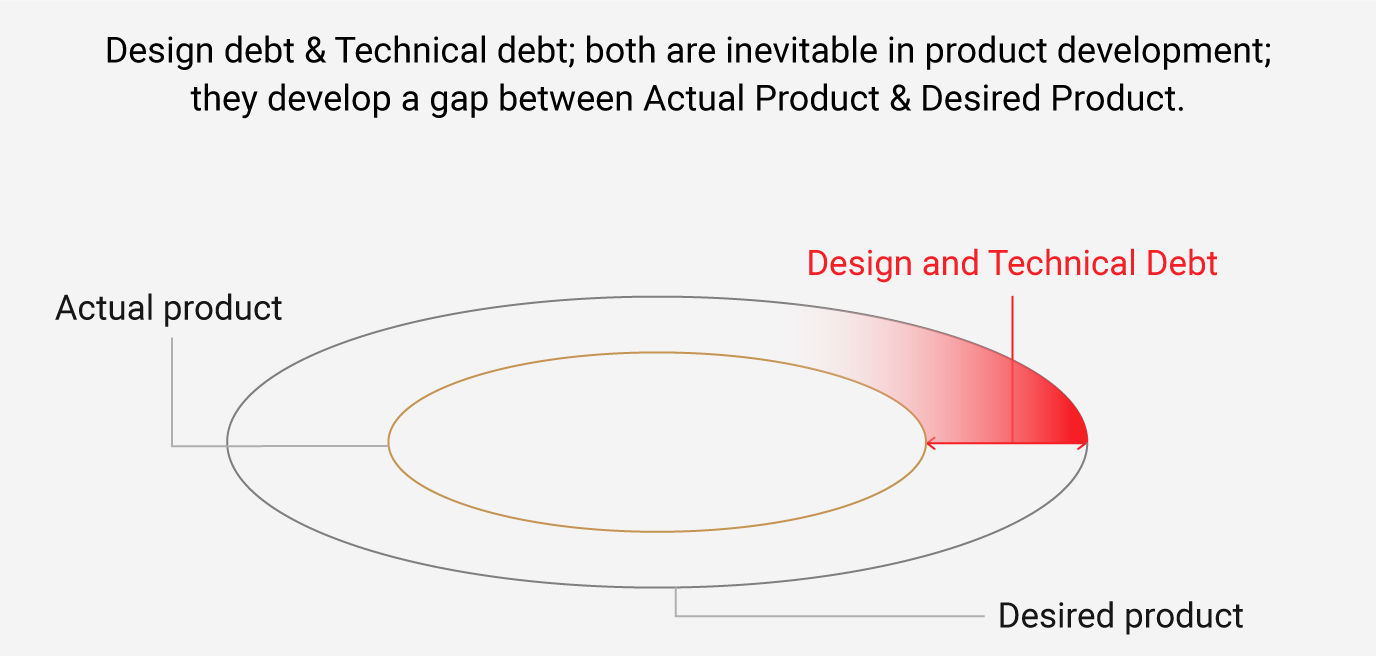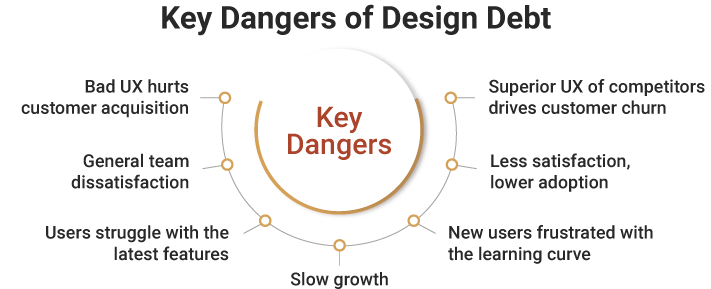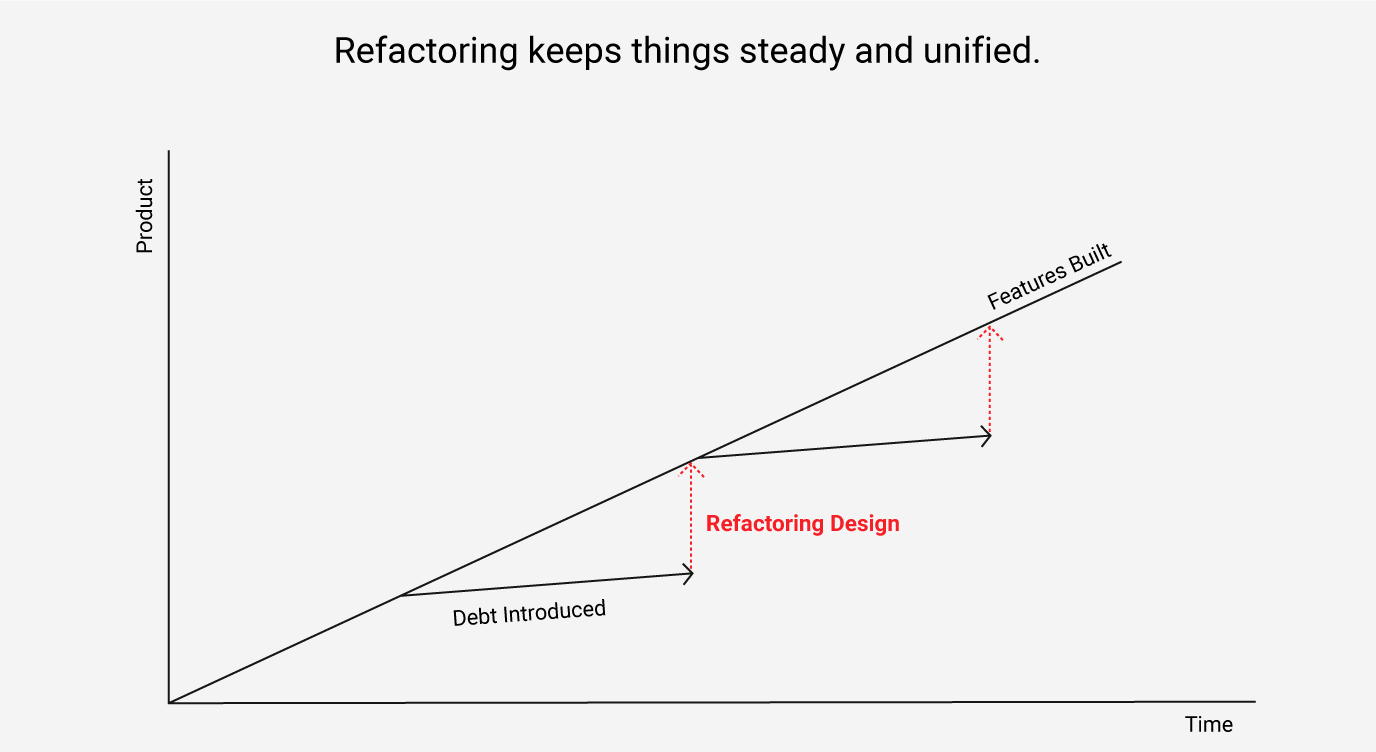
Design debt issue: How to detect and manage?
In today’s rapidly evolving market, entrepreneurs must act swiftly to adjust and surpass their competitors. The process involves developing software products through iterative methods while embracing agile philosophies and the “Launch early” approach.
However, launching early often comes at a cost—
To keep pace, the developers release products many-a-times without correct planning, optimized applications, or proper code reviews. In turn, the designers renovate the interface and include features without assessing the users’ genuine necessities or the components’ context. It results in the building up of technical debt and design debt. Technical debt affects the robustness of the code base, whereas design debt affects the solidity of the user interface.
Design debt is a natural falloff – a side effect of development that mounts over time due to market volatility and product evolution.
Realizing that you have accrued UX/design debt might be daunting and challenging to manage. Therefore, knowing beforehand how to detect and get it managed at the earliest before it becomes too late is the workable way.
Before discussing any further on this topic, let’s first look at what differentiates design debt from technical debt.
Design debt Vs. Technical debt
Tech debt appears when development teams choose ad hoc or trade-off solutions that often annoy the roadmap. Technical debt is easy to detect, unlike design debt, since a poorly designed code stops working once deployed, or results in emergencies or production breakdown. In contrast, Design Debt is more personal as you and your users decide what quality is acceptable. So, it is more subtle while creeping in and then can be super heavy to deal with.
However, technical debt and UX debt go hand in hand. Massive tech debt can slow down the development of features and growth. Design debt turns into technical debt over time and adds to total debt.

So, focusing on either one – UX Debt or Tech Debt can create issues not only for users but also becomes expensive for firms.
Design debt: What exactly is it?
To put it simply, design debt, also referred to as the lesser cousin of tech debt, is the sum of all the inadequacies that pop up over time due to errors, incompetencies, innovation, and growth. It implies everything right from the process of design thinking to user experience issues.
Where does the design (UX) debt come from?
Be mindful of identifying the situations that can give rise to UX debt. Here’s an overview of the concerns that can lead to product designing debt –
- When you and your Agile teams are hyper-focused on creating a product that might produce a new revenue stream, failing to consider whether the feature that fits into your product plan and original goal.
- You decided to place your feature where your traffic is at its highest, overlooking the relevance to its users.
- Lacking time and budget to work on each core feature with the same care.
- Neglecting user testing of the interface before execution
- Failing to observe the user’s behaviours and product analytics post product launch.
Which projects can run at risk of designing debt?
The projects that can typically get exposed to such kind of risks might have the following features:
- Projects that lack properly defined scope or managed documentation. The teams generally need to manage tight deadlines and changing market situations/growth. It poses a challenge for them to bestow equal attention to every aspect.
- Project based on assumption and not on research. Failing to research the user’s objectives and needs before designing any product during the planning and development stages can lead to consequences such as a complex user journey, floating specifications, and confused navigation.
- You start with a tentative project management plan. Designers conceptualize a product based on their perspectives, which might result in divergent viewpoints, inconsistent design, or a misconception of its intended use.
- Lack of resources or requirements errors or poor communication. Overlooking potential design flaws when handing over features to developers can lead to delays, rework, extra costs, and bad user experience.
- Prioritizing short-term goals over design can harm the product’s long-term prospects. Appending features without proper planning and forcing them into layouts, resulting in the design diverging from the intent.
- Existing product UX/UI status and overall product design direction when not considered while developing a new feature (For instance, if the team is very experimentation-focused, trying to revolutionize portions while losing sight of how they integrate with the rest).
- Deprived workflows and communication gap between developers, designers, and QA. The designers hand off a feature to the developers, but they don’t execute it. And this in turn, results in deviations and then design flaws that are overlooked or rectified at the last minute, leading to rework, delays, and additional expenses.
Key dangers of Design Debt?
If not detected or managed on time, the design flaws can lead to various consequences. Check it; what are those –
- Bad UX hurts customer acquisition
- Slow growth
- Less satisfaction, lower adoption.
- General team dissatisfaction
- New users are frustrated with learning the curve.
- Users struggle with the latest features
- Superior UX of competitors causes customer churn.

How to Detect and Prioritize Design Debt
Design debt typically results naturally from a software product’s iterative process of achieving the ideal product-market fit. However, it can also be brought on by other things. The analysis of user feedback and app usage analytics must begin as soon as possible in the product development cycle to detect such concerns.
Prioritize the following areas where possibly there are chances to build up design debt-
- Interaction design (movement from page to page, scrolling effects & navigations)
- User Interface (buttons, links, visual styling)
- Copy, content, and messaging (headlines, levels, and written texts)
- Accessibility components (text alternatives, visual focus indicators, contrasts, etc.)
- Customer journey consistency
- Omnichannel seamlessness
- Information architecture (content classification and navigation)
In what ways can design debt be tackled?
There is no single effective solution that can help you to tackle the design debt issue. The key to maintaining healthy design debt levels is to make planning a priority – indeed it makes all the difference.

Here are ways to tackle the product design debt issue-
# 1 Have a design debt backlog
Determine the root cause of the UX debt to start with. The first step is to determine how and why the UX debt developed. It might be the outcome of deliberate choices made by product teams. Keep an eye on the UX and design debt backlog like a tech debt backlog.
# 2 Prioritize depending upon the user’s journey debt impact
You can detect new UX (design) debt with regular user testing sessions done in carefully planned focus groups, and probably find more issues than you hope to fix. Prioritization and understanding what is crucial and less critical are essential for managing different sorts of UX debt.
# 3 Assign time for UX debt clear-ups and hire talented front-enders
Investing time to clear off UX debt issues and hiring experts for your product design and development is always decisive. If you have the budget, always plan to appoint front-end specialists since they will probably have an eye for minor design details. In this regard, “pair programming “between the designers and front-end developers can be helpful.
# 4 Perform product reviews to avoid design debt
Assessments of design add a second filter for evaluating work before it is released into the public eye. It can allow you to prevent UX debt from building up in the first place. At the very least, a formal design sign-off /review for significant new features can help to bridge the gap between designers and engineers so that they can better comprehend the nuances of each field.
Ending Words
Design debt is the critical facet affecting your product experience and seriously impacting your company’s bottom line. Determine your software product’s current UX maturity level; it can be the starting point. By doing so, you can subsequently build a roadmap to improve your design (UX) issue and minimize it over time.
Access our on-demand personnel of skilled product managers, software engineers, and UX designers assisting product owners worldwide to accurately assess their current position about the UX design maturity framework and help create a roadmap to tackle design debt.
Share this post
About the Author

Sujoy Roy
(Head – Digital Marketing)
From my teenage time, I had a quench to solve problems and loved leadership. Starting my career in relation management, ignited my passion for managing people. While managing I realized technology needs to be incorporated to keep pace with the changing world & do my work efficiently.

